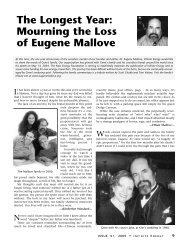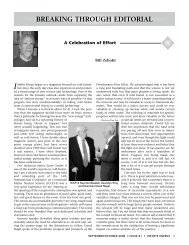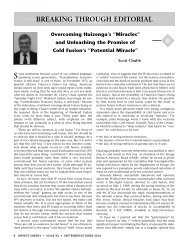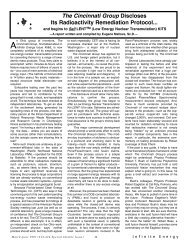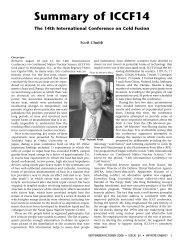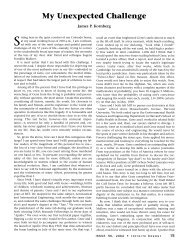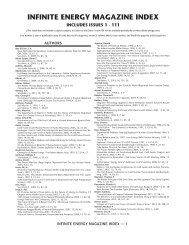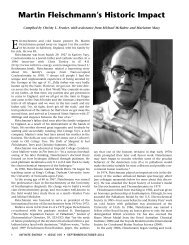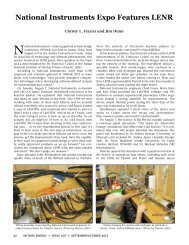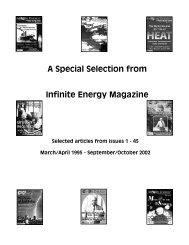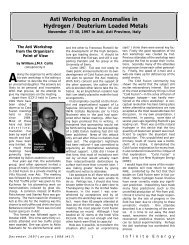MIT and Cold Fusion: A Special Report - Infinite Energy Magazine
MIT and Cold Fusion: A Special Report - Infinite Energy Magazine
MIT and Cold Fusion: A Special Report - Infinite Energy Magazine
Create successful ePaper yourself
Turn your PDF publications into a flip-book with our unique Google optimized e-Paper software.
<strong>MIT</strong> <strong>and</strong> <strong>Cold</strong> <strong>Fusion</strong>: A <strong>Special</strong> <strong>Report</strong><br />
Compiled <strong>and</strong> written by Eugene F. Mallove, Sc.D.<br />
<strong>MIT</strong> Class of 1969, S.B. Aero/Astro Eng., 1970 S.M. Aero/Astro Eng.<br />
Photo: E. Mallove<br />
Introduction<br />
When on March 23, 1989 Drs. Martin Fleischmann <strong>and</strong> Stanley<br />
Pons announced that they had measured nuclear-scale<br />
excess energy from a palladium-heavy water electrochemical<br />
cell, <strong>and</strong> that they had also detected some preliminary evidence<br />
of nuclear signatures from their exotic energy-producing reactions,<br />
the world was in awe. Their famous afternoon press conference<br />
at the University of Utah, coming less than twelve hours<br />
before the Exxon Valdez ran aground off Alaska’s pristine coast<br />
<strong>and</strong> spilled millions of gallons of oil, reminded us of the serious<br />
problems linked with fossil fuel dependency. The Chernobyl<br />
nuclear reactor accident of 1986 also hovered in the background.<br />
It was already clear that conventional fission nuclear<br />
power was in deep political trouble in many countries. The close<br />
coupling of energy <strong>and</strong> the environment was growing ever more<br />
apparent.<br />
Following the Utah disclosure, the prospect loomed of a<br />
quantum leap in energy technology—a solution to the dilemma<br />
of fossil fuel domination <strong>and</strong> its threats to the environment <strong>and</strong><br />
world peace. The Utah claims soon came to be known as “cold<br />
fusion,” because the electrochemists were saying that they had<br />
solved the problem that the plasma physicists <strong>and</strong> engineers in<br />
the “hot” fusion program had been working on for four<br />
decades.<br />
The hot fusioneers had been trying to mimic the stars—to<br />
“bring the power of the Sun down to Earth” in the form of controlled,<br />
thermonuclear fusion. This was the attempt to use the<br />
deuterium in ordinary water as an effectively infinite fuel supply.<br />
In only one cubic kilometer of ocean, the nuclear fusion<br />
energy that could be extracted from the approximately<br />
1/6,500th fraction of water’s hydrogen that is heavy hydrogen<br />
exceeds the combustion energy content of all the known oil<br />
reserves on Earth.<br />
Tantalizing as the prospect of infinite energy from the oceans<br />
was, the hot fusion program had never generated even a single<br />
watt of excess power in its huge plasma reactors, which cost<br />
hundreds of millions of dollars per year to support. Success—<br />
“break-even” or “more energy out than in”—with magnetically-confined<br />
hot plasma fusion always seemed to be twenty<br />
years away. This led to the perennial joke that hot fusion is “the<br />
energy source of the future. . .<strong>and</strong> always will be.” Moreover,<br />
even if the hot fusion program were to succeed in building a<br />
commercially viable central-station generator of electricity<br />
sometime in the year 2050 or beyond, the technology would<br />
have serious limitations. The energy from the hot fusion reaction<br />
of deuterium <strong>and</strong> radioactive tritium, which had to be supplied<br />
in bootstrap-fashion from the reaction, would emerge in<br />
the form of deadly neutron radiation (14 MeV neutrons). That<br />
would have to be transformed into more benign thermal energy<br />
in a hot jacket of molten lithium in order to heat water for<br />
steam-generated electricity. The practical engineering problems<br />
would be enormous, the technology would add more nuclear<br />
waste to the global inventory (though not as much as conventional<br />
fission power, or so claim the tokamak hot fusion advocates),<br />
<strong>and</strong> it was far from certain to be economically viable.<br />
In fact, in October 1983 <strong>MIT</strong> Professor of Nuclear Engineering,<br />
Lawrence M. Lidsky, published an article (“The Trouble<br />
with <strong>Fusion</strong>”) condemning the hot fusion program. It was a<br />
high-profile cover story for <strong>MIT</strong>’s Technology Review. The stark<br />
black <strong>and</strong> white cover of the issue read, “Even if the fusion program<br />
produces a reactor, no one will want it.” Other key<br />
remarks made by the outspoken Lidsky, who was then an Associate<br />
Director of the Plasma <strong>Fusion</strong> Center: “Long touted as an<br />
4 <strong>Infinite</strong> <strong>Energy</strong> • ISSUE 24, 1999 • <strong>MIT</strong> <strong>Special</strong> <strong>Report</strong>



